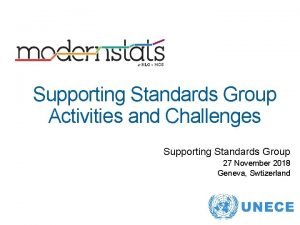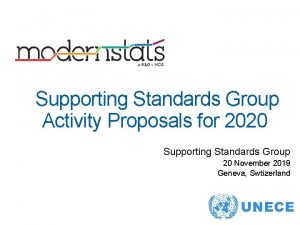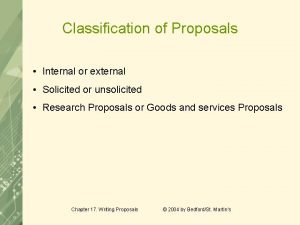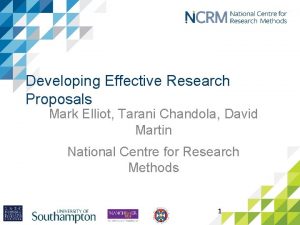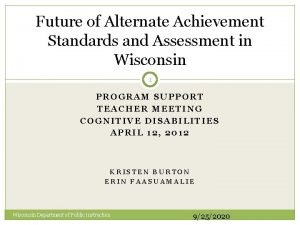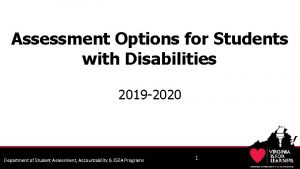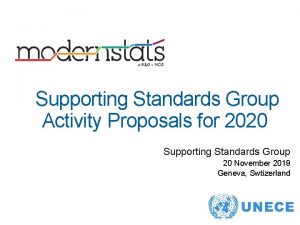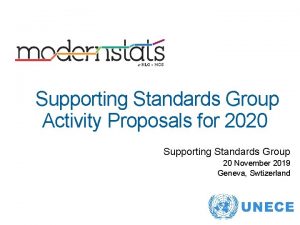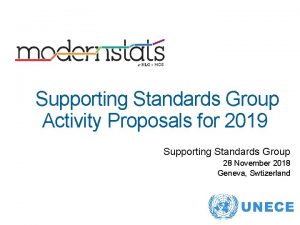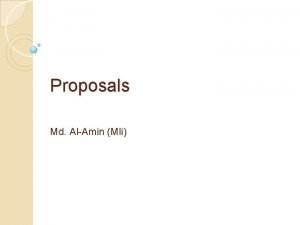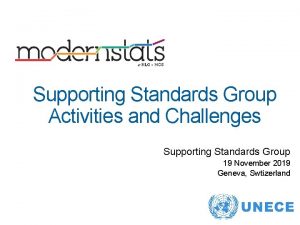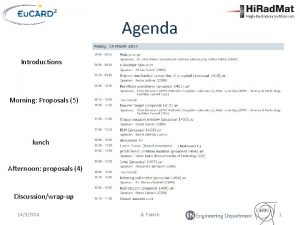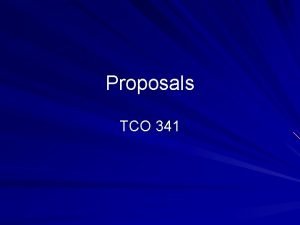Supporting Standards Group Activity Proposals for 2020 Supporting


















- Slides: 18

Supporting Standards Group Activity Proposals for 2020 Supporting Standards Group 20 November 2019 Geneva, Swtizerland .

Activity proposals for 2020 1. Linking GSBPM & GSIM 2. Core Ontology for Official Statistics Continuation from 2019 activity 3. Metadata Glossary New activity proposals 4. Detailing GAMSO Corporate Support activities in connection to GSBPM 6. Application of GSBPM for Geospatial Information 5. Task team for GSIM 7. GSBPM tasks

Activity proposals for 2020 Supporting Standards Group welcome new members to work on these activities! Let us know if you are interested in working with us!

1. Linking GSBPM & GSIM • In 2019, a conceptual template and diagrams linking GSBPM sub-processes with GSIM information objects were developed and the mapping GSBPM phase 5 “Process” was done and examples from countries were collected • A document was produced • The task team asks for a continuation of work during 2020 to complete the mapping and examples from countries for the remaining GSBPM phases and sub-processes

1. Linking GSBPM & GSIM Benefits 1. Better understanding of how the two models are related, thus supporting a wider use of the models themselves 2. Contributing to build “de facto” a more integrated view of the Modern. Stats Models 3. This integration makes it easier to create CSPA Services 4. This integration makes it easier to review and align the terminology used in the models that could be an activity undertaken by the Ontology and Metadata Glossary team

1. Linking GSBPM & GSIM Planned outputs: 1. Mapping of GSIM and GSBPM for other GSBPM phases 2. Creating governance model to GSIM-GSBPM mapping 3. Creating relevant documentation, including communication paper 4. Adding relevant GSIM objects into Clickable GSBPM

2. Core Ontology for Official Statistics • In 2019, core concepts that are cutting across different models were identified. The team produced definitions of theses core concepts, properties and the specification of the links between this base ontology and the external vocabularies • Version 1 of the ontology was completed • The task team asks for a continuation of work in 2020: – January: Start of public review – February-March: Work on articulation with work on GSIM and CSPA – April-May: Work on governance – June-July: Final version 1 of the ontology – August-September: Document on governance – October-November: Submission to HLG-MOS for adoption

2. Core Ontology for Official Statistics Planned outputs – A URI policy for UNECE RDF resources – The Core Ontology as an OWL/Turtle file in English/French/Spanish, validated by public review and referenced in LOV. – An ontology description and users guide (English) – New versions of previous works on GSIM, CSPA and the SDMX metadata model – A document on the governance

3. Metadata Glossary • Intended to be a central, unified and definitive source for the terms and definitions in the Modern. Stats Models • Planned output: alphabetically organized list or terms, their definitions, sources for the definitions, source of the term (in which standard(s) does it appear), explanatory text that further contextualizes the meaning, and references to other similar, broader, and narrower terms • Completed review of terms of GAMSO and GSBPM and in 2019 review of half of the GSIM terms ( totally, 150 terms) • The task team asks for a continuation of work until April 2020 to complete of GSIM terms

4. Detailing GAMSO Corporate Support activities in connection to GSBPM • In 2019, a task team worked on the Alignment of GSBPM Overarching Processes and GAMSO Activities New activity: • make explicit how the remaining Corporate Support Activities included in GAMSO relate to the activities of the 8 GSBPM phases • define the relationship of Activities in GAMSO and GSBPM with Data Management Body of Knowledge (DMBK)

4. Detailing GAMSO Corporate Support activities in connection to GSBPM Benefits: • Increased usability of both models • Support for a wider adoption of GAMSO • Increased harmonisation between Modern. Stats Models • Support for an integrated view and synergic adoption of both models Work: • A dedicated task team of Supporting Standards Group

5. Task team for GSIM • GSIM is a reference framework for statistical information and provides a set of standardised, consistently described information objects. • Many statistical organisations are now starting to use GSIM and facing challenges implementing the model. • As a more technical and recent model, GSIM needs support to develop a user community. • These needs were strongly expressed at the 2019 Modern. Stat World Workshop and GSIM e-training. • The activities of the Supporting Standards Group in 2019 also showed some inconsistencies and needs for clarifications in GSIM v 1. 2.

5. Task team for GSIM • New activity: – “Soft updates” of GSIM to clarify ambiguous points and fix minor errors. More significant error will be compiled for the next GSIM revision. – Review of GSIM User Guide (2012) and update it to reflect changes made in GSIM v 1. 2 and recent experiences – Regular virtual meetings to present GSIM case studies and discuss implementation issues – One or two dedicated sprints • Work: – A dedicated task team of Supporting Standards Group

6. Application of GSBPM for Geospatial Information • Potential of geospatial information to enrich statistical information is gaining great interest within official statistical community. • To ensure good quality of geospatial information and its integration with statistical information, it is necessary that activities to collect, process and analyse geospatial information are taken at the right stage throughout the production process. • GSBPM is a de-facto standard for statistical production process model and hence an ideal tool to document activities needed for geospatial information during the production. • The purpose of this activity is to provide a guidance on how to use GSBPM to incorporate geospatial information for statistical production process

6. Application of GSBPM for Geospatial Information • New activity: – Review the relevant works done at the international/regional level as well as national level – Write a guidance on how to use GSBPM with geospatial information by extending the description in GSBPM focusing on activities needed for geospatial information • Work: – A dedicated task team of Supporting Standards Group

7. GSBPM tasks • GSBPM has gained wide adoption within statistical community and become a de-facto standard for process model. • The activities and their descriptions remain at a high-level to keep the model generic • Several oganizsations have added lower level activities (i. e. more detailed activities than GSBPM sub-processes) when they adopt GSBPM for local setting. • The purpose of this activity is to compile examples of these lower-level activities (henceforth called “task”) to provide a set of common tasks without losing the generic nature of the model

7. GSBPM tasks • New activity: – collecting examples from countries that have added tasks to their national version of GSBPM; – identifying common tasks used by these countries; – creating a document summarizing the findings – Provide inputs for next revision of the GSBPM • Work: – A dedicated task team of Supporting Standards Group

Final remarks • Supporting Standards Group is aware of the amount of work and asks the HLG and EB for advice on priority • A preliminary discussion on priorities also started within the Supporting Standards Group • However, the proposals are very closed linked one to each other and to the work and results the Group is achieving in the last two years • The high number of activity proposals is an indicator of the interest of statistical organisations towards Modern. Stats Models as well as of the commitment of the members of the Group
 Group activity standards
Group activity standards Standards for group activity
Standards for group activity Writing thesis and dissertation proposals
Writing thesis and dissertation proposals Title fly and title page
Title fly and title page Writing and completing reports and proposals
Writing and completing reports and proposals Formal business report
Formal business report Artificial intelligence thesis proposals
Artificial intelligence thesis proposals What is solicited external
What is solicited external Insurance proposals fire insurance
Insurance proposals fire insurance Capital investment decision
Capital investment decision Developing effective research proposals
Developing effective research proposals Eclipse computing proposals slow
Eclipse computing proposals slow Delhi muslim proposals
Delhi muslim proposals 6 priorities of national core standards
6 priorities of national core standards Aacsb standards 2020
Aacsb standards 2020 Colorado reading standards 2020
Colorado reading standards 2020 Alabama alternate achievement standards
Alabama alternate achievement standards Science test
Science test Vdoe calculator accommodation
Vdoe calculator accommodation
